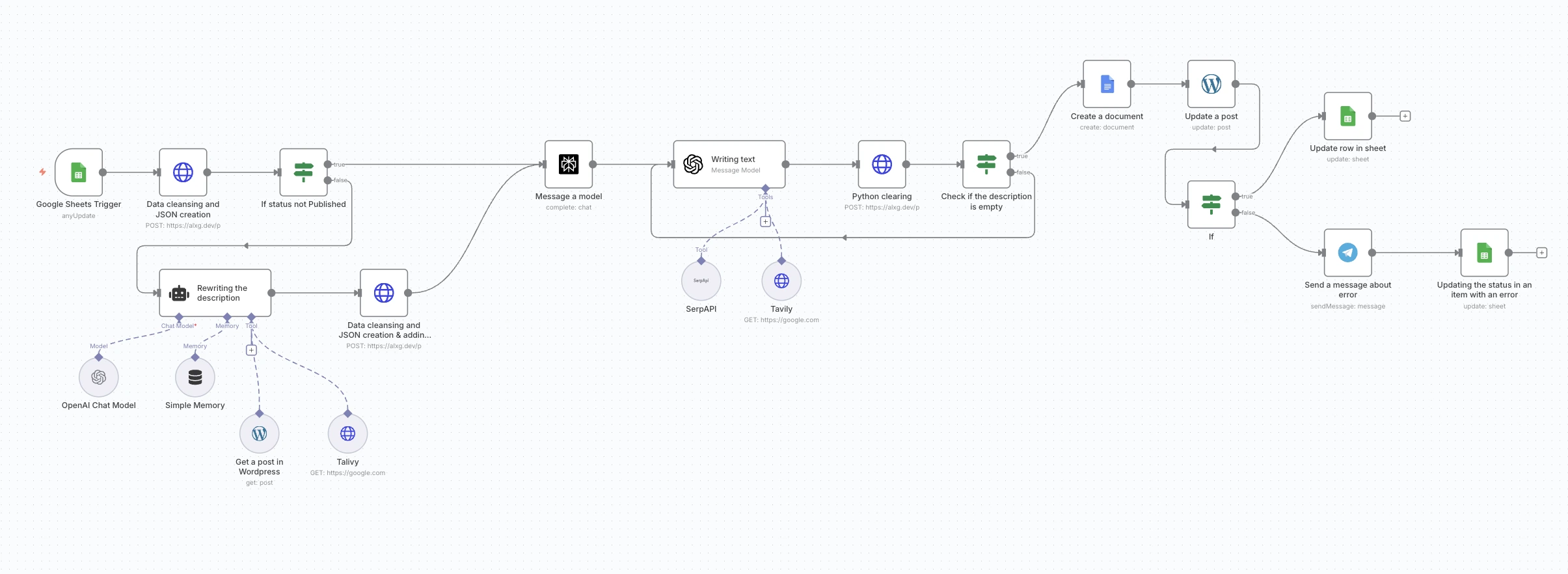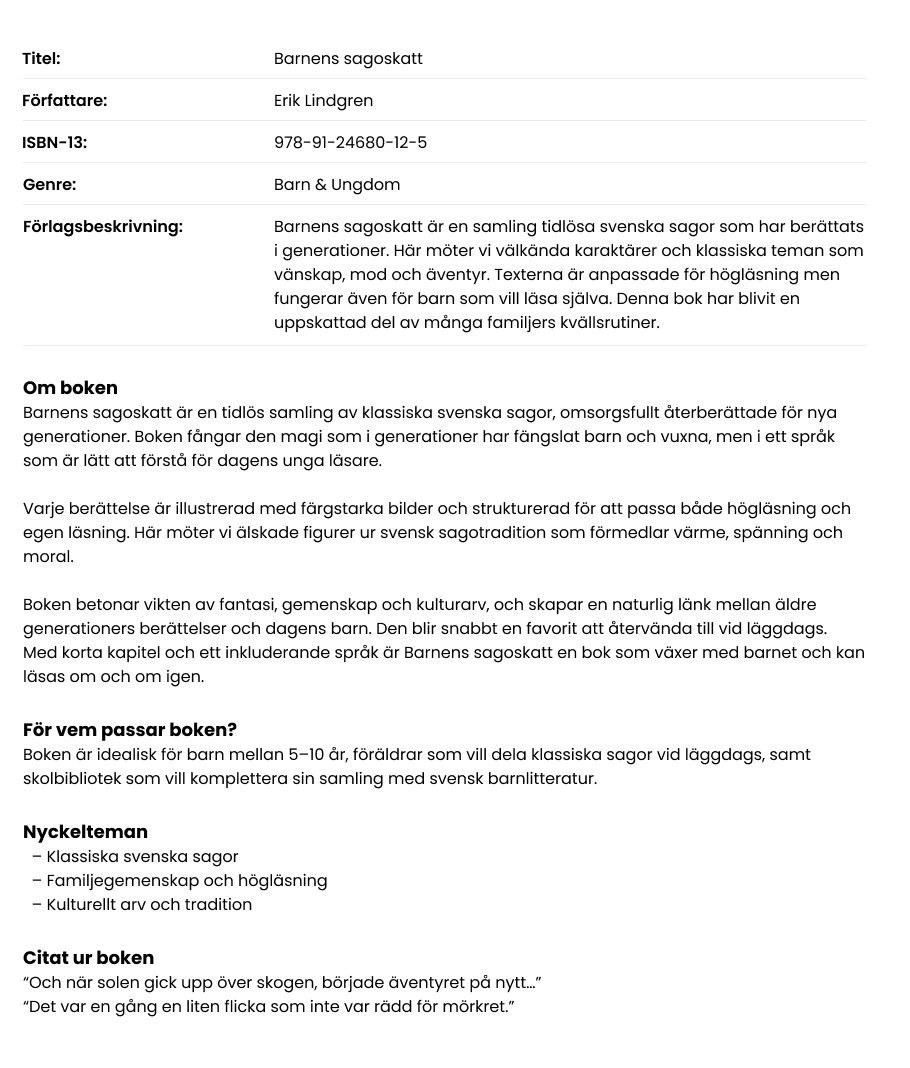At first glance, the task seemed simple and predictable, but during the process many challenges and hidden pitfalls emerged that had to be solved.

The Problem
The owner of an online bookstore in Sweden faced a classic situation: the catalog contained several thousand books, but the product pages were almost empty. They only included the title, author, ISBN, and a short publisher’s annotation.
This created three immediate issues:
- 🔍 Poor search indexing — without unique descriptions, the pages failed to rank well on Google.
- 🛒 No value for users — the product pages looked dry and unappealing, which reduced conversions.
- ⏳ Editors couldn’t handle the volume — manually preparing even 1,000 unique descriptions would take weeks of work for an entire team.
In practice, the business was left with a choice: either hire 4–5 editors and spend the budget on routine work, or find a way to automate the process.
The Solution
When the bookstore owner reached out with a short description of the problem, I proposed building a pipeline that would fully automate the creation of book descriptions. For this, the following stack was chosen: n8n + Python (in Docker) + OpenAI + WooCommerce REST API.
Implementation Steps:
Data Collection & Cleaning
- Source data (title, author, ISBN, genre, annotation) was stored in Google Sheets.
- A Python script validated ISBNs, removed duplicates, and normalized genres and formats. This eliminated “dirty” input data.
AI-Powered Description Generation
- With Perplexity API we pulled in extra context — real reader reviews and critic overviews — to enrich the descriptions.
- n8n passed the prepared data to OpenAI.
- The model generated detailed, SEO-optimized descriptions that included:
- 3–4 paragraphs of main text,
- a block explaining who the book is for,
- a list of key themes or genre features,
- several quotes from the book.
HTML Template Formatting
- Python converted the text into clean HTML.
- This ensured the descriptions looked polished, not like raw AI output.
WooCommerce Integration
- Each description was saved to Google Drive as a Google Doc and logged in Google Sheets (with the Doc link and metadata such as meta tags).
- Through the WordPress REST API, product pages were automatically updated in the store with the new descriptions.
- For the bookstore team, the process was fully transparent — updates appeared without employee involvement.
Revision Mechanism in Admin Panel
- In the WordPress editor I added a “Send for Revision” button and a comment field.
- If an editor wasn’t satisfied (e.g., the text felt too generic), they could leave short remarks.
- The request was automatically sent back into n8n, AI refined the description considering the comments, updated both Google Docs and WordPress, and the status in Google Sheets changed from To Update → Updated once corrections were applied.
This is what the table looked like initially:

This is what the table looks like after automation:

Here’s what the descriptions looked like before — just the basic details and a short publisher’s annotation, with no depth or SEO optimization.

After automation, each book received a full presentation with a unique description, audience targeting, key themes, and quotes — everything ready for online publishing and SEO results.

Results
The impact of the implementation became noticeable almost immediately.
🚀 In the first 2 weeks, the system processed over 4000 books.
💰 The bookstore didn’t have to hire additional editors — saving hundreds of man-hours.
📈 Just 3 months after implementation:
- Organic traffic to book pages that previously had no descriptions grew by 10–15%.
- The site began receiving traffic from new long-tail queries, e.g. “buy psychology books about anxiety in Swedish”, “best detective novels for teenagers 2022 buy online”.
- CTR in search increased by around 8–10% thanks to richer snippets.
- Average time on page rose by 15–20%, as users started reading the detailed descriptions and quotes.
- Adding new books to the catalog dropped from several hours to just a few minutes.
Editors also received a convenient feedback tool: any description could be sent back for revision in one click with notes — completely eliminating email or messenger back-and-forth with copywriters.
Why this stack?
n8n
a flexible open-source automation tool that’s easy to deploy on the client’s server.
Python in Docker
used not only for data validation but also for fine-tuning HTML templates so descriptions look like handcrafted editorial copy.
OpenAI
enabled automated writing without sacrificing quality.
WordPress REST API
allowed updating thousands of product pages without manual CSV imports.
Do you want the same solution for your store?

Turn raw catalog data into SEO-ready product pages – fully automated. I build an end-to-end workflow that cleans your product data, generates structured SEO content, creates meta tags, and publishes directly to WordPress/WooCommerce. Works for books, cosmetics, gadgets, fashion, supplements—any catalog-driven business.
- Saves time by generating thousands of product descriptions in hours, not months.
- Improves SEO with unique texts and optimized meta tags.
- Provides full control with statuses, logs, and revision workflow.
- Reduces costs by eliminating the need for large content teams.
- Scales easily to any product type and multilingual catalogs.
I connect Google Sheets, n8n, Python, and WordPress/WooCommerce to build a fully automated content pipeline.
I prepare and structure your data before publishing, so descriptions stay consistent and SEO-ready.
I create AI-powered multi-paragraph descriptions with proper headings and meta tags.
I set up direct publishing to WordPress/WooCommerce and save a copy in Google Docs.
I enable easy updates: you leave notes in the sheet, and the system rewrites and republishes automatically.
I configure notifications for failed tasks and status tracking inside Google Sheets.

